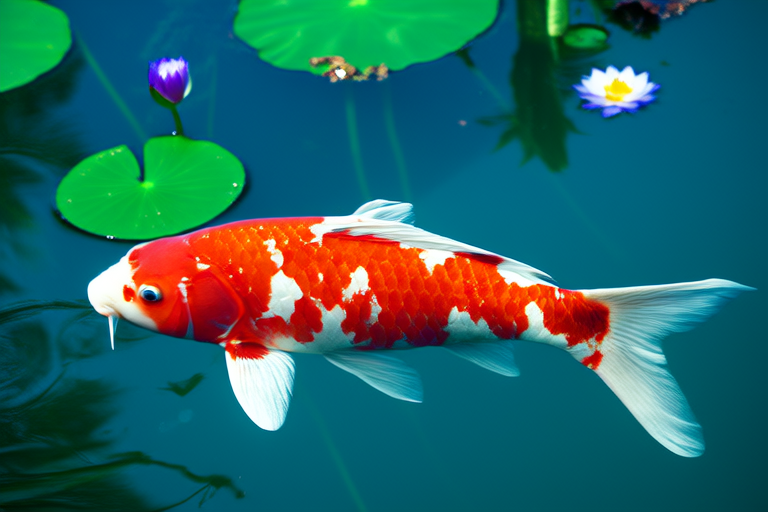The Ultimate Guide: Feeding Habits of Koi Fish Explained
Koi fish, known for their vibrant colors and graceful movements, have become a popular choice for ponds and water gardens. Proper nutrition is key to ensuring these aquatic beauties thrive and maintain optimal health. This comprehensive guide will delve into various aspects of koi feeding, offering insights and practical advice for both novice and seasoned koi keepers.
Types of Food Suitable for Koi Fish
The diet of koi fish should be balanced to meet their nutritional needs. A variety of foods can be included in their diet:
- Pellets: High-quality commercial pellets form the backbone of a koi’s diet. These are available in different sizes to suit the size of the koi and are designed to float on the surface of the water, allowing koi to feed easily.
- Vegetables: Fresh vegetables such as lettuce, spinach, and zucchini can be fed to koi. They provide fiber and vitamins that are beneficial for their digestive system.
- Fruits: Small amounts of fruits like apples or grapes can be offered occasionally. However, fruits should be given sparingly due to their high sugar content.
- Insects: Live or freeze-dried insects can be added to the diet to enhance protein intake. Daphnia, bloodworms, and brine shrimp are popular choices.
Frequency and Quantity of Feeding
Feeding koi fish correctly involves understanding how much and how often to feed them. The general rule is to feed them small portions several times a day rather than one large meal. Overfeeding can lead to poor water quality and health issues.
The amount of food should be adjusted based on the temperature of the water. In warmer months when the water temperature is between 60°F and 75°F (15°C – 24°C), koi can be fed up to three times a day. As the temperature drops below 60°F (15°C), reduce the frequency to once or twice daily. When the water temperature falls below 50°F (10°C), it’s best to stop feeding altogether as koi become less active and their metabolism slows down.
Seasonal Dietary Adjustments
Seasonal changes significantly affect the nutritional requirements of koi. During winter, when the water temperature is low, koi require fewer nutrients because their metabolic rate decreases. Feeding high-protein diets during this period can cause stress and health problems. Instead, opt for low-protein, wheat-based pellets.
Conversely, during spring and summer, when the water is warm and koi are more active, they need higher protein diets to support growth and energy expenditure. It’s also important to ensure that the food you provide is easily digestible at lower temperatures.
Potential Health Issues Related to Incorrect Feeding Habits
Improper feeding can lead to several health issues in koi fish:
- Overfeeding: Excessive feeding leads to uneaten food sinking to the bottom of the pond, causing an increase in harmful bacteria and algae. This can result in poor water quality and oxygen depletion.
- Underfeeding: Insufficient feeding can lead to malnutrition, stunted growth, and weakened immune systems, making koi more susceptible to diseases.
- Incorrect Diet: Feeding inappropriate foods can lead to digestive issues, obesity, and liver problems.
Monitoring the health of your koi is crucial. Regularly check for signs of distress such as lethargy, abnormal swimming patterns, or visible lesions. If any of these symptoms are observed, it may be necessary to adjust their diet or seek professional help.
Tips for Maintaining Water Quality
Maintaining good water quality is vital for the health of koi fish. Here are some tips:
- Adequate Filtration: Use efficient filtration systems to remove waste and debris from the water. Biological filters help break down harmful substances like ammonia and nitrite.
- Regular Water Changes: Perform routine partial water changes to dilute accumulated toxins and replenish essential minerals.
- Bio-Availability: Ensure that the food you provide is bio-available, meaning it breaks down quickly and is easily digestible by the koi. This reduces the amount of waste produced and improves digestion.
Scientific Insights
Understanding the biological processes behind koi feeding can help in providing better care. Koi are cold-blooded animals whose metabolic rates depend on the ambient water temperature. At higher temperatures, their metabolism increases, leading to greater energy requirements. Conversely, at lower temperatures, their metabolism slows down, reducing their need for food.
The digestive system of koi is adapted to process plant matter efficiently. Their stomachs have a specialized structure that allows them to break down cellulose, which is abundant in plant-based foods. However, this adaptation does not mean that koi can survive solely on plants; they still require protein for muscle development and overall health.
Practical Advice for Beginners and Experienced Koi Keepers
For beginners, starting with a basic pellet diet and gradually introducing other foods is recommended. It’s essential to observe the behavior of your koi to understand what they prefer and how much they eat. Experienced koi keepers might experiment with different types of food and feeding schedules to optimize the health and appearance of their fish.
Both groups should focus on creating a stable environment with consistent water parameters and feeding routines. Regular maintenance of the pond and monitoring the health of the koi are key practices for long-term success.
Conclusion
Proper feeding is crucial for the well-being of koi fish. By understanding their nutritional needs, adjusting diets according to seasons, and maintaining excellent water quality, you can ensure that your koi remain healthy and vibrant. Whether you’re new to koi keeping or a seasoned expert, adhering to these guidelines will help create a thriving aquatic ecosystem.
